




Changi Airport, Southeast Asia’s busiest airport with hundreds of thousands of passengers on a typical day, sat near empty for months. The sprawling Angkor Wat complex, normally bustling with tourists in the peak months of January to April, fell silent.
These scenes, which look straight out of a dystopian movie, paint a dynamic region on pause.
As COVID-19 cases began surfacing in various parts of the globe, ASEAN governments imposed increasingly stricter policies to limit people’s movement and contain the virus. From a temporary entry ban on foreigners travelling from COVID-19-affected countries in January and February, governments started implementing more drastic measures by mid-March. They closed national borders, suspended visa issuance, prohibited the entry and transit of foreign nationals, and even banned outbound travel.
Travel Industry in the Doldrums
Although draconian measures were necessary, they dealt a devastating blow to the travel and tourism industry in the region. The United Nations World Tourism Organization reports that Southeast Asia recorded a 64 per cent decline in visitor arrivals during the first half of 2020 over the same period last year. This translates to billions of dollars of lost revenue for Southeast Asian economies. Data from the ASEAN Policy Brief indicate that Cambodia, Thailand, and the Philippines are likely to be the hardest hit, with their travel and tourism industries accounting for a large portion of their GDP, export revenues, and employment. Not far behind are Malaysia, Lao PDR, and Singapore.
In the travel and tourism value chain, the aviation industry is floundering the most. Several airlines in the region, from national carriers like Singapore Airlines and Thai Airways to low-cost carriers such as AirAsia and Cebu Pacific, have had to furlough or retrench staff, or cut working hours and staff salaries to staunch financial bleeding. Straits Times, for example, reported that Singapore Airlines reduced the salaries of its pilots by as much as 60 per cent, and will be eliminating 4,300 positions in the coming weeks.
The hotel and restaurant sector is not spared. Stay-at-home orders, restrictions against indoor gatherings, and booking cancelations have forced hotels and restaurants to close—some temporarily; others, for good. A hotel and restaurant association in Indonesia reported that some 550,000 hotel employees and one million registered restaurant workers have been either furloughed or laid off since the start of the pandemic. In Thailand, the number of laid off hotel employees has reached one million, a local hotel association estimated.
The pandemic’s ripple effects have also been felt by tour operators, bus and car rental companies, souvenir shops, and a host of other tourism-dependent micro-, small and medium enterprises, displacing millions more workers.
A Shift to Domestic Tourism
In recent months, ASEAN governments have begun relaxing their lockdown measures and domestic travel restrictions as health protocols were put in place and as COVID-19 cases became more manageable.
National tourism authorities took this opportunity to shift their focus on the domestic market to resuscitate their countries’ battered travel and tourism industry. Viet Nam was among the first to do so after successfully controlling the spread of the coronavirus. In early June, it introduced the “Vietnamese People Travel in Viet Nam” programme which encourages citizens to patronise local tourist destinations. Thailand followed suit, launching its “We Travel Together” campaign in July, which offers Thai nationals discounted rates for airline tickets, hotel bookings, and visits to tourist attractions.
Dr. Puvaneswaran Kunasekaran, Honorary Treasurer of the ASEAN Tourism Researchers Association and Associate Director of the Centre for Research and Innovation in Tourism of Taylor’s University, Malaysia, said industry players have no choice but to turn to domestic tourism with international borders still closed. At the same time, demand is returning as local tourists are eager to travel. “For example, when the Malaysian government lifted the inter-state travel ban in June, we saw the number of domestic tourists increase. You couldn’t get a room in top tourist destinations for the weekend,” Kunasekaran said.
Reviving International Travel through Travel Bubbles
Southeast Asian countries that came out relatively unscathed have started opening up their borders to other countries that were similarly successful in containing COVID-19. This exclusive arrangement, called travel bubble or corridor, allows people to move freely within the corridor sans the usual burdensome travel requirements, such as mandatory two-week quarantine upon arrival. Singapore, for example, has started setting up reciprocal green lanes for essential short-term business and official travel with a number of countries in the region, including Malaysia, Brunei, and Indonesia.
The regional bloc is hoping to build on these initiatives and establish a region-wide travel bubble. On 12 November, the ASEAN Leaders took a decisive first step by issuing the ASEAN Declaration on an ASEAN Travel Corridor Arrangement Framework, which tasks the ASEAN Coordinating Council, with support from the ASEAN Coordinating Council Working Group on Public Health Emergencies, to take the lead in developing a regional framework that includes a common set of pre-departure and post-arrival health and safety measures to protect ASEAN citizens.
While the travel corridor is initially intended for business travellers, Kunasekaran views this as a good starting point that will pave the way for ASEAN to harness the full potential of intraregional travel, which has been lagging even before the pandemic hit the region. “We have 622 million people in ASEAN, but I can tell you that intra-ASEAN travel—meaning visitors from Singapore to Malaysia, Indonesia to Thailand, etc—was only about 51 million in 2019. It was about 35 million 10 years ago,” he said. In contrast, he said, Europe’s intraregional tourist flow is about 250 million, a third of its 740 million population.
Kunasekaran said that one strategy that governments can do is steer tourists to hidden gems or off-the-beaten-path travel destinations that are far less crowded and therefore much safer. “Let’s say in Indonesia, international tourists would want to go to Bali, but rather than sending them there, industry players can send them to unknown, unpolished locations,” he said. This will be appreciated by a new generation of travellers who want an authentic tourism experience in lesser known, but “instagrammable” destinations, Kunasekaran added.
Another strategy is to strengthen road connectivity and travel between landlocked countries in ASEAN. “Not everyone can afford air travel. In Europe, half of the 250 million travellers travel by car, by land since road mobility is good,” Kunasekaran said. This strategy requires the cooperation of countries to develop road networks, travel routes and itineraries, and special passes.
Opportunities for Digital Solutions
In many ways, the travel and tourism industry is among the early adopters of digital solutions for business processes and consumer services. Consider, for example, online airline booking and ticketing, online lodging platforms such as Airbnb and Vrbo, and travel planner apps such as TripIt, which have become ubiquitous over the years.
The pandemic has given the industry an extra nudge to ramp up digitalisation not only to improve the efficiency of service providers, but also to enhance the travel experience of consumers. With safety concerns foremost on the minds of travellers, there is a huge gap to fill in terms of developing “contactless” or “touchless” technology solutions.
Some countries have already started. In Singapore, a number of hotels are now using an AI-enabled digital concierge that can handle guests’ item requests, take room service orders, book facilities, and answer queries on a 24/7 basis. In the Philippines, the tourism department ensured that accredited tourism establishments and restaurants have free access to locally-developed apps for regulating foot traffic and contacttracing, and for digital restaurant ordering and cashless payment.
The regional bloc recognises the vast potential of digital solutions for revitalising the travel and tourism sector in the midst of the current crisis. ASEAN Leaders seek to send a strong signal of support by issuing the ASEAN Declaration on Digital Tourism, which encourages Member States to cooperate on developing new digital platforms, database systems, and value chain connections; create a favorable environment to facilitate adoption of digital technologies by MSMEs and tourism institutions; improve the digital competence of the tourism workforce; and use digital solutions to promote safe and seamless travel experience during and after the current COVID-19 pandemic.
Light at the End of the Tunnel
Even with the impending vaccine roll-out, the travel and tourism industry is not likely to bounce back anytime soon. “According to various authorities, it will take three years for the industry to reach the level it achieved in 2019,” Kunasekaran said. “It still depends on how good the vaccine mobilisation will be.”
In the meantime, domestic tourism, digital tourism, and intraregional travel are offering the industry a way out of the slump and to gradually recoup its losses while waiting for the vaccines to work and for pre-COVID normalcy to return.








